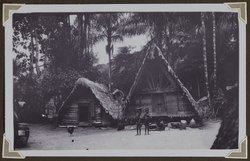Ovia Olo Ovillanhollo | |
|---|---|
Village | |
 Children in front of house ijn Ovia Olo (c. 1930) | |
| Coordinates: 5°30′47″N54°24′30″W / 5.513056°N 54.408333°W | |
| Country | |
| District | Marowijne District |
| Resort | Patamacca |
| Population (2017) [1] | |
• Total | c.300 |
Ovia Olo, also Ovillanhollo, is a village of Ndyuka Maroons in the Patamacca resort of the Marowijne District of Suriname. [2]
Electricity for the village is provided by diesel generators. [3] The village does not have a school. [2]
In 2011, [4] the Marowijne Art Park was opened on the East-West Link near Ovia Olo. [5] The Art Park consists of works of art made by international artists, and contributions from the children of Moengo, Ovia Olo and Ricanaumofo. [6]
In 2016, Zhong Heng Tai Investment was given permission to start a 40,000 hectares palm oil plantation [1] even though the village authorities had voted against the plan in 2005. The village was initially not opposed to the plan until the scale was revealed. [7] A smaller plantation had existed near the village between 1975 and 1980, but was destroyed during the Surinamese Interior War. [1]
